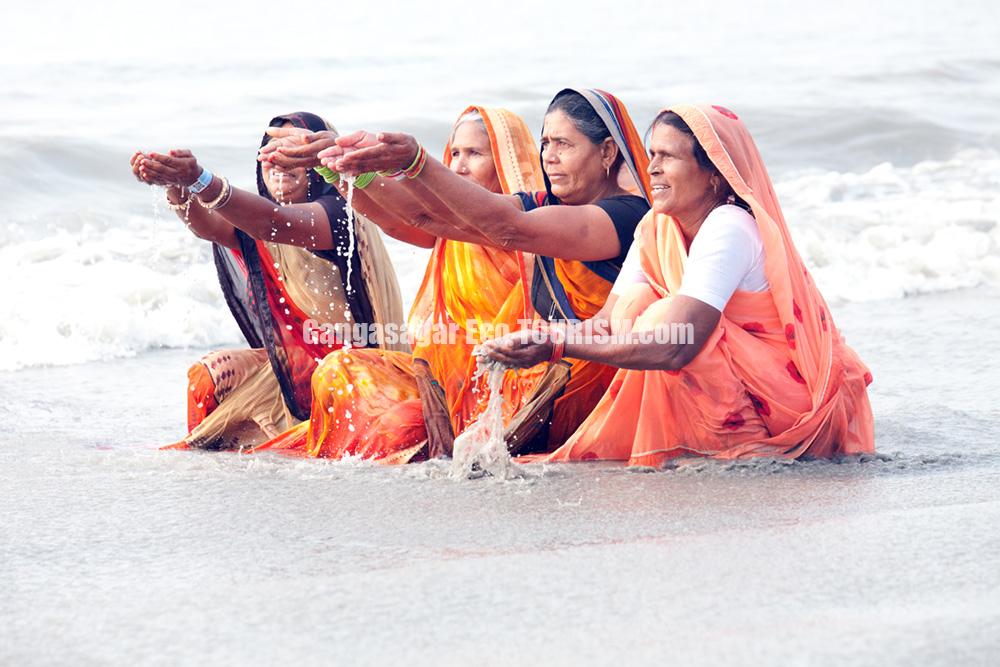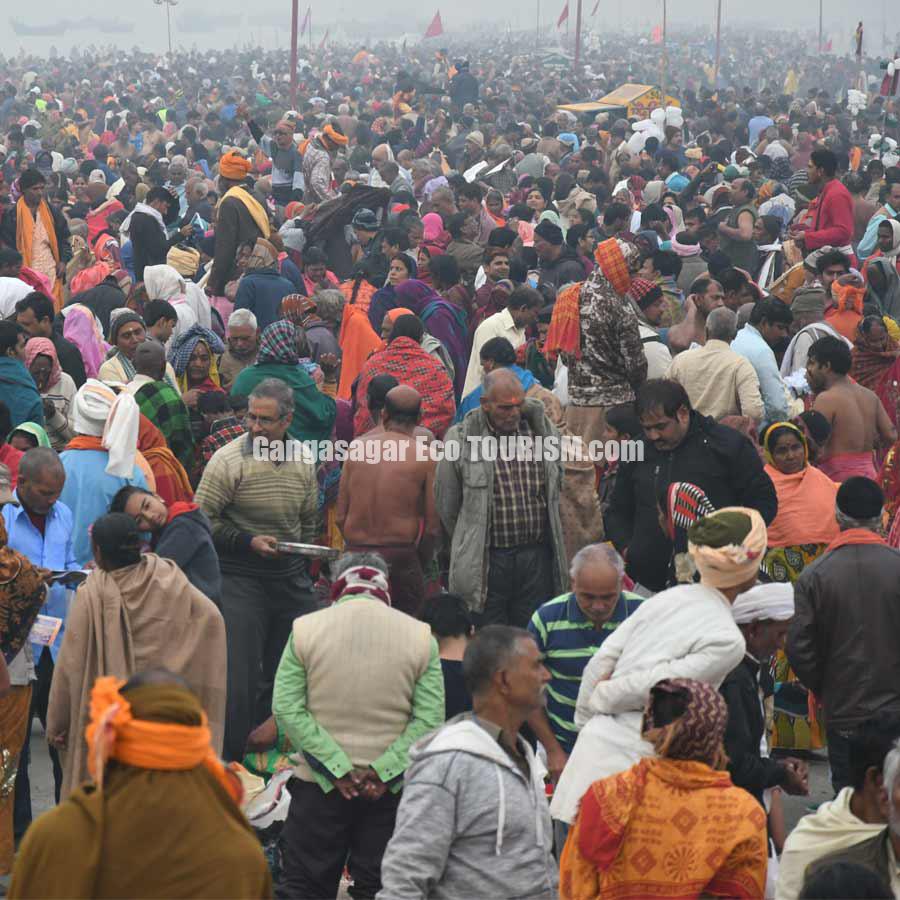 GANGASAGAR
GANGASAGARThese are the hymns that has been immortalized in the heart of every pilgrim who every year travel across the length and breadth of the country to reach the sacred shores of the Gangasagar. The gravitas of the Gangasagar mela are beautifully encapsulated by the spirit of the devotees who be
lief that taking a dip in the holy water of Gangasagar will help them to attain moksha. With just over a month left for the Mela, the South
24 Parganas District Administration, is taking exceptional efforts to safeguard the health and safety of pilgrims by following every Covid guidelines, so that the devotees can celebrate their unwavering fa
ith on the shores of mysticism.
Gangasagar, the land where faith meets belief, lies about 100 Km from Kolkata on the southern tip of the Gangetic delta, under the jurisdiction of South
24 Parganas, West Bengal. Gangasagar or Sagar Island, a tract of land cut from the mainland, creates an unparallel religious ambience with vast swathes of silver sands, clear sky, deep blue ocean and the iconic Kapil Muni Ashram. These are the shores where the holy Ganges meets the ocean after a journey of thousands of kilometres.
Gangasagar is po
etry in motion. The pilgrimage to Gangasagar is a reflection of the fascinating journey from Samsara (cyclicality of life, death, and existence) to Nirvana (Moksha/Salvation), a journey that has captivated scholars, writers, rationalists, and spiritualists for ages. The teeming multitude of Gangasagar Mela is a visual insight of man’s relentless quest from mundane to spiritual.

According to mythological sources, Ganga’s descent on Earth from heaven was due to a plethora of events that unfolded over centuries. At the confluence of this great river is the site where pilgrims believe that they can attain moksha.
Let us now turn the pages of ancient mythology to discover more about this pilgrimage of celestial proportions.
At the heart of Gangasagar lies the temple of Kapil Muni.This great saint is who is an avatar of Lord Vishnu, was born to Kardam Muni and Debahuti Devi. Going by the mythological stories,all his life,Kardam Muni had dedicatedly followed all directions of Vishnu for his only wish was that the Lord be born as his son. His wish was finally granted with the birth of Kapil Muni.
King Sagar is the other indispensable character whose name itself is a source of inspiration of the name Gangasagar. This Ayodhyan king was peforming his 100th Ashwamedha yajna when Lord Indra intervened.
Fearing that he might lose his throne if Sagar acquired too much piety, Lord Indra hid the sacrificial horse under the Kapil Muni ashram (Patal). Seething with rage, King Sagar sent his 60,000 sons on a mission to find the missing horse. His sons went on a rampage, in and around Sagardwip and finally reached Kapil Muni’s hermitage. The saint was meditating when they interrupted him and accused him of theft.
With a single glance, Kapil Muni turned King Sagar’s sons into ashes. Years later, the grandson of King Sagar, upon guidance from Kapil Muni meditated for long to persuade Ganga to descend to Earth from heaven.
Through Maheswar’s (Shiva) hair, Devi Ganga trickled down from the Himalayas and washed away the sins of Sagar’s sons.
The same Ganga that freed the souls of 60,000 people now inspires lakhs of people from not just India but all over the world to congregate and take a holy dip. And all of this is aimed at attaining moksha: the ultimate freedom of the soul.


Gangasagar Mela is held during the auspicious period of Makar Sankranti. The Hindu calendar is luni-solar calendar where adjustments are made regarding lunar and solar cycles to keep track of seasons. This is why the date of Gangasagar Mela usually varies between 14th and 15th January each year.
The first day of the solar month is Makara, when the sun is believed to be entering the Makar rashi phase, which again corresponds with the sun sign, Capricorn. The other word, Sankranti, refers to the transition of the sun from one phase to the other. There are 12 Sankrantis in total, of which Makar and Karka are of massive significance in terms of religious beliefs.
The climate also undergoes remarkable change during this time. Held soon after winter solstice, this is the time when days finally start to get longer and nights get shorter. This reflects an intrinsic tie between Jyotisha practices and astronomical movements. Since Vedic times this ancient system of knowledge has been a guiding light for an entire civilization and what is awe inspiring is the fact that it remains relevant even to this day!

More often than not, religion is deeply embedded with the culture of the land, and Gangasagar, held on Makar Sankranti is no exception to that norm.
Gangasagar is more than a pilgrimage; it is the intermingling of emotions with faith; it is the celebration of life itself.
In many parts of India this is the time of harvest and for some it the season after crops have been sowed. So, it comes as no surprise that people want to show their respect to the Sun God for bestowing upon them the ideal climate. Besides this they also show their gratitude towards the earth, the crops and the cattle.
Various sweet dishes are made at Indian households comprising fresh ingredients like sesame and jaggery.
The celebrations are not only centered around food. A significant practice is the flying of kites. Originally a north-Indian phenomenon, this has become very popular and spread to many parts of India. In Delhi, January 14th is celebrated as Kite Flying Day every year.
Thus, we see that it is deeply embedded in the social fabric of the land, an indispensable part of its culture that keeps everyone bound together.


A beach that stretches as far as your eyes go, teeming with devotees. The earthy scent of incense filling the dense January air. The bells chiming loud in sync with mantras, spreading a mystic charm all around. When you witness all of this at once, you know you are at Gangasagar.
The most important ritual in Gangasagar is dipping oneself in the holy water early in the morning. It is nothing but unwavering faith that inspires the lakhs of pilgrims to fight against the biting cold.
At first the saints who descend from the Himalayas, including the Naga sadhus undertake the sahisnan. This is followed by the general Gangasagar snan of the assembled devotees. Their hopes and prayers are all directed towards the attainment of ‘moksha’- the ultimate freedom of the soul.
The devotees also offer prayers to the Sun God and perform rituals called ‘tarpan’ in remembrance of their ancestors and in the hope that their souls too will be freed from the mortal world.
After doing this people congregate at the temple of Kapil Muni to perform ‘maha pujas’ and even ‘yajnas’. The powerful saint is thus remembered and his blessings sought.
The Naga sadhus also bless the devotees who visit them by carrying out performances that inspire awe.
In the evening, the diyas (earthen lamps) are lit and they float down the magnificent river. Evening aarti is also conducted where chanting of matras fills the air with a religious fervor. A million diyas floating down the river reminds one of the journey of humankind itself.


Every year, millions of devotees with a heart full of unwavering faith cascade on to the shores of Gangasagar in search for moksha. Lakhs and Lakhs of pilgrims across India and neighbouring nations travel to the white shores of Sagar Island on Makar Sankranti to take a dip in the holy confluence of the Ganges and the ocean.
The number of pilgrims visiting the Gangasagar Mela has soared with each passing year. The availability of improved facilities at the Mela premises or during the Gangasagar Yatra has spurred the enthusiasm of the devotees. The 2018 Gangasagar Mela, attracted close to 15 lakh pilgrims. In 2019, the figure increased to 20 lakhs. To cope with the massive footfall, the Government of West Bengal installed 500 CCTVs between Babughat and Sagar Island to keep a close tab on Sagar Yatra. 3000 Policemen were deployed to maintain law and order.
The 2020 Gangasagar Mela witnessed a technological revolution, with the authorities introducing initiatives such as E-Snan, where the holy Ganga water would be directly delivered to the door steps; Sagar Sanjog, which provided the pilgrims with real-time information about the movement of pilgrims and vehicles. 60 giant LED screens were placed at strategic points to inform pilgrims about the timings of transportation, tides and safety protocols in three languages: Bengali, Hindi and English.
The 2021 Gangasagar Mela was successfully executed in spite of the COVID-19 Pandemic. Strict COVID protocols were in place as more than 30 lakh people participated in the Mela. Medical screening camps, RAT/ RTPCR testing facilities were set up inside the mela ground. 1050 CCTVs were used to track the crowd in real time. Crowd management was implemented with the help of drone tracking and GPS/RFID based Intelligent Crowd Monitoring. E-Darshan was introduced to broadcast the mela online.
Crowd management was implemented with the help of drone tracking and GPS/RFID Based Intelligent Crowd Monitoring. For the first time, E-Darshan was introduced to broadcast the mela online. New initiatives like Sagar Bharaman, a guided tour for senior citizens & PWDs; e-Puja, offering puja at the ashram from home; Sagar Sangralay, a museum chronicling the history of Gangasagar and many more will be introduced to make an incredible experience for the pilgrims.
